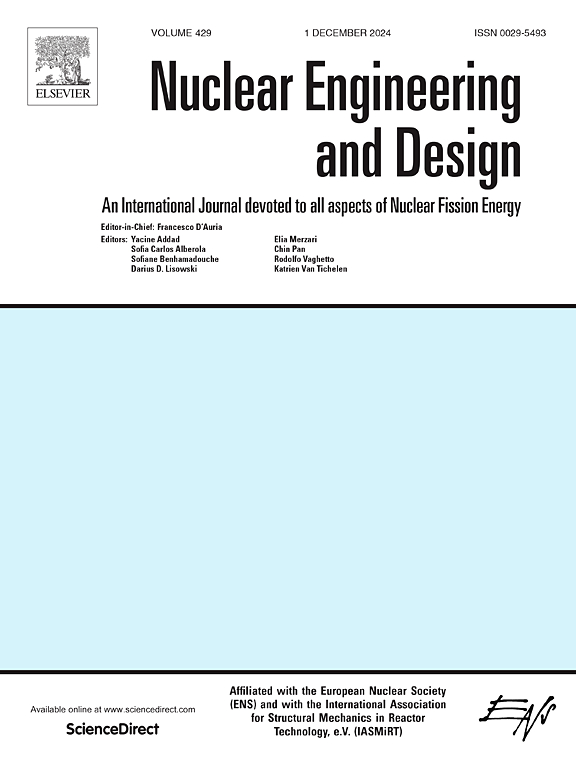采用UO2和MOX配置的西屋铅快堆的核心设计和性能
IF 2.1
3区 工程技术
Q1 NUCLEAR SCIENCE & TECHNOLOGY
引用次数: 0
摘要
西屋公司与阿贡国家实验室合作,为西屋公司追求的中型(950 MWt)铅快堆设计、建模和优化UO2和mox燃料堆芯。利用Argonne的反应堆分析代码套件和Westinghouse的燃料成本经济模型,对数千个候选堆芯进行了考虑,以实现本文提出的经济优化堆芯。该优化过程考虑了详细的反应堆物理、燃料性能、瞬态性能和燃料经济学模型。本文对优化后的UO2燃料堆芯和mox燃料堆芯的性能进行了描述和比较。这两种堆芯的燃料性能和瞬态行为都被认为是可以接受的,可以用于本文提出的优化方案,而需要对材料在高温液态铅中的性能进行进一步的测试,以确认所选操作条件下的可接受性。采用多批次策略对UO2堆芯进行优化,以获得最佳的燃料利用率和最小的燃料库存成本。MOX堆芯选择了单批次燃料管理,以最大限度地延长循环长度,并最大限度地减少由于排放的MOX燃料相对于排放的UO2燃料的衰变热更高而导致的更长换料中断的影响,因为在排放的燃料进行干举之前需要更长的冷却时间。本文章由计算机程序翻译,如有差异,请以英文原文为准。
Core design and performance of the Westinghouse lead fast reactor with UO2 and MOX configurations
Westinghouse partnered with Argonne National Laboratory to design, model and optimize UO2- and MOX-fueled core designs for a medium size (950 MWt) Lead Fast Reactor that was pursued by Westinghouse. Using Argonne’s suite of reactor analysis codes together with Westinghouse fuel cost economic models, thousands of candidate cores were considered to achieve the economics-optimized cores presented in this paper. This optimization process considered detailed reactor physics, fuel performance, transient performance, and fuel economics models. The reactor performance of the resulting optimized UO2- and MOX-fueled core designs are described and compared in this paper. Both cores show fuel performance and transient behavior that is considered acceptable for the optimization presented herein, while further testing campaigns on material performance in high-temperature liquid lead will be required to confirm acceptability at the operating conditions chosen. A multi-batch strategy was selected for the UO2 core for best fuel utilization with minimum fuel inventory costs. A single-batch fuel management was instead selected for the MOX core to maximize cycle length and minimize the impact of the longer refueling outage resulting from the higher decay heat of the discharged MOX fuel relative to the discharged UO2 fuel, requiring a longer cooling time before dry-lift of discharged fuel could take place.
求助全文
通过发布文献求助,成功后即可免费获取论文全文。
去求助
来源期刊

Nuclear Engineering and Design
工程技术-核科学技术
CiteScore
3.40
自引率
11.80%
发文量
377
审稿时长
5 months
期刊介绍:
Nuclear Engineering and Design covers the wide range of disciplines involved in the engineering, design, safety and construction of nuclear fission reactors. The Editors welcome papers both on applied and innovative aspects and developments in nuclear science and technology.
Fundamentals of Reactor Design include:
• Thermal-Hydraulics and Core Physics
• Safety Analysis, Risk Assessment (PSA)
• Structural and Mechanical Engineering
• Materials Science
• Fuel Behavior and Design
• Structural Plant Design
• Engineering of Reactor Components
• Experiments
Aspects beyond fundamentals of Reactor Design covered:
• Accident Mitigation Measures
• Reactor Control Systems
• Licensing Issues
• Safeguard Engineering
• Economy of Plants
• Reprocessing / Waste Disposal
• Applications of Nuclear Energy
• Maintenance
• Decommissioning
Papers on new reactor ideas and developments (Generation IV reactors) such as inherently safe modular HTRs, High Performance LWRs/HWRs and LMFBs/GFR will be considered; Actinide Burners, Accelerator Driven Systems, Energy Amplifiers and other special designs of power and research reactors and their applications are also encouraged.
 求助内容:
求助内容: 应助结果提醒方式:
应助结果提醒方式:


